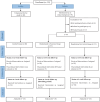Effects of 12-week combined interval running and resistance training on cardiac structure and performance in patients with type 1 diabetes
- PMID: 40162367
- PMCID: PMC11954380
- DOI: 10.1177/20420188251325148
Effects of 12-week combined interval running and resistance training on cardiac structure and performance in patients with type 1 diabetes
Abstract
Background: Exercise has been suggested to effectively improve cardiac performance in children with type 1 diabetes (T1D) by enhancing the glycemic control. The purpose of this study was to investigate (1) effects of a 12-week combined interval running and resistance training (CIRRT) and (2) 1 month of detraining on cardiac structure and myocardial performance in adolescent males with T1D.
Methods: A total of 72 participants, including 48 adolescent males with T1D (fasting blood glucose (FBG): 274.67 ± 52.99 mg/dL, age: 15.20 ± 1.78 years) and 24 healthy adolescents (FBG: 90.75 ± 5.47 mg/dL, age: 15.08 ± 1.67 years), were recruited to the study. Participants were allocated into diabetes exercise (DE), diabetes control (DC), and healthy controls (HC) groups. The DE group performed 12 weeks of a CIRRT program three times per week. Blood glucose profile, echocardiography (ECHO) indices, and peak oxygen consumption (VO2peak) were measured pre- and post-intervention and following 1-month detraining period. Repeated measures ANOVA was used for pre- and post-intervention comparisons within the DE group and across the three study groups. Significance level was set at p < 0.05.
Results: Exercise intervention resulted in decreased hemoglobin A1c (HbA1c% = Pre: 10.44 ± 2.03, Post: 9.38 ± 1.66, p < 0.05), FBG, left ventricular (LV) internal diameter, and both tricuspid and mitral deceleration time (DT) in the DE group. VO2peak, ejection fraction (EF% = Pre: 62.38 ± 1.6, Post: 64.08 ± 1.18, p < 0.05), fractional shortening, early tricuspid diastolic inflow E velocity, and tricuspid velocity during atrial contraction were also increased following the exercise training. HbA1c (Pre vs Follow-up: 9.83 ± 1.73, p < 0.05), EF (Pre vs Follow-up: 62.97 ± 1.56, p < 0.05), LV, and DT tricuspid remained significantly improved after detraining period compared to the baseline. In the baseline, the glycemic index and ECHO variable significantly differed in the DE and DC groups with the HC group (p < 0.05). However, after the intervention, the DC and HC groups did not change significantly (p > 0.05).
Conclusion: The CIRRT intervention was associated with improved cardiac structure and performance in male adolescents with T1D potentially due to exercise-induced adaptations. Meanwhile, the results indicate that most cardiac morphological and functional changes are reversible following periods of inactivity in patients with T1D.
Keywords: VO2Peak; echocardiography; heart; interval running training; resistance training; type 1 diabetes.
© The Author(s), 2025.
Figures





Similar articles
-
A High intensity Interval training (running and swimming) and resistance training intervention on heart rate variability and the selected biochemical factors in boys with type 1 diabetes.Diabetes Res Clin Pract. 2023 Oct;204:110915. doi: 10.1016/j.diabres.2023.110915. Epub 2023 Sep 22. Diabetes Res Clin Pract. 2023. PMID: 37742805
-
Cardiac Function is Preserved in Adolescents With Well-Controlled Type 1 Diabetes and a Normal Physical Fitness: A Cross-Sectional Study.Can J Diabetes. 2021 Dec;45(8):718-724.e1. doi: 10.1016/j.jcjd.2021.01.010. Epub 2021 Jan 23. Can J Diabetes. 2021. PMID: 33773936
-
[Effect of positive end-expiratory pressure on cardiac function in patients with early left ventricular diastolic dysfunction: a prospective cohort study].Zhonghua Wei Zhong Bing Ji Jiu Yi Xue. 2022 Oct;34(10):1066-1071. doi: 10.3760/cma.j.cn121430-20220414-00369. Zhonghua Wei Zhong Bing Ji Jiu Yi Xue. 2022. PMID: 36473565 Chinese.
-
One-year unsupervised individualized exercise training intervention enhances cardiorespiratory fitness but not muscle deoxygenation or glycemic control in adults with type 1 diabetes.Appl Physiol Nutr Metab. 2018 Apr;43(4):387-396. doi: 10.1139/apnm-2017-0222. Epub 2017 Nov 20. Appl Physiol Nutr Metab. 2018. PMID: 29156141
-
Rapid-Acting Insulin Analogues Versus Regular Human Insulin: A Meta-Analysis of Effects on Glycemic Control in Patients with Diabetes.Diabetes Ther. 2020 Mar;11(3):573-584. doi: 10.1007/s13300-019-00732-w. Epub 2019 Dec 23. Diabetes Ther. 2020. PMID: 31873857 Free PMC article. Review.
References
-
- Palmieri V, Capaldo B, Russo C, et al.. Uncomplicated type 1 diabetes and preclinical left ventricular myocardial dysfunction: insights from echocardiography and exercise cardiac performance evaluation. Diabetes Res Clin Pract 2008; 79(2): 262–268. - PubMed
LinkOut - more resources
Full Text Sources

